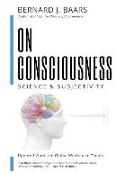- Start
- On Consciousness: Science & Subjectivity - Updated Works on Global Workspace Theory
On Consciousness: Science & Subjectivity - Updated Works on Global Workspace Theory
Angebote / Angebote:
The works of Bernard Baars collected here are among the foundational texts of the scientific study of consciousness. Their influence in cognitive science and philosophy of mind is enormous, and their impact on my own thinking has been profound." -Murray Shanahan, Professor of Cognitive Robotics, Dept of Computing, ICLGlobal Workspace Theory (GWT) began with this question: "How does a serial, integrated and very limited stream of consciousness emerge from a nervous system that is mostly unconscious, distributed, parallel and of enormous capacity?"GWT is a widely used framework for the role of conscious and unconscious experiences in the functioning of the brain. A set of explicit assumptions that can be tested, as many of them have been. These updated works, from the recipient of INNS 2019 Hermann von Helmholtz Life Contribution Award, form a coherent effort to organize a large and growing body of scientific evidence about conscious brains. Throughout human history, people have perceived the conscious brain as the great nexus of human life, of social relationships, of their personal identities and histories, in encounters with new challenges. Consciousness under its many labels and manifestations is widely seen to be one of the core mysteries of life. Many therapeutic approaches can be viewed in a global workspace framework, including traditional psychodynamics and depth psychology, but also cognitive behavioral techniques, and, indeed, many other kinds of carefully studied human functions. Making progress in understanding consciousness therefore has an endless number of implications - philosophical, metaphysical, scientific, medical, clinical, and practical.A valuable reference for technical audiences and a vigorous intellectual hike for the layman." -Kirkus ReviewsHow can we understand the evidence? The best answer today is a 'global workspace architecture, ' first developed by cognitive modeling groups led by Alan Newell and Herbert A. Simon. The term "global workspace" comes from Artificial Intelligence, where it refers to a fleeting memory domain that allows for cooperative problem-solving by large collections of specialized programs. Global Workspace Theory (GWT) therefore assumes that the brain can be viewed as a "society of mind." Global Workspace (GW) theory is consistent with our current knowledge, and can be enriched to include other aspects of human experience. Stan Franklin and co-workers have built on GWT to sketch out a more general theory of cognition - LIDA: Cognitive Architecture's Computational Implementation of GWT. Stanislas Dehaene and Jean-Pierre Changeux in Paris developed experimentally testable models, making further testable claims about the brain basis of visual consciousness - The Dehaene-Changeux Model (DCM): Global Neuronal Workspace is Part of GWT.Global Workspace Dynamics (GWD) is the most current version of GWT - attempting to account for complexities of the living brain. These updated works trace the beginnings of GWT/GWD through the continued rise of brain evidence and psychological understanding. On Consciousness is an indispensable addition to the library of both students and experts studying mind, brain, and behavior. "Bernie Baars is a giant on whose shoulders the future science of consciousness will stand." -Antti Revonsuo, PhD, Professor of Cognitive Neuroscience, University of Skövde, Sweden
Folgt in ca. 15 Arbeitstagen


![Notes from a Catalogue of Pamphlets in Worcester College Library [by C.N.O. Daniel.]](https://support.digitalhusky.com/media/annotations/sorted/270/27006063/CHSBZCOP0327006063.jpg)

